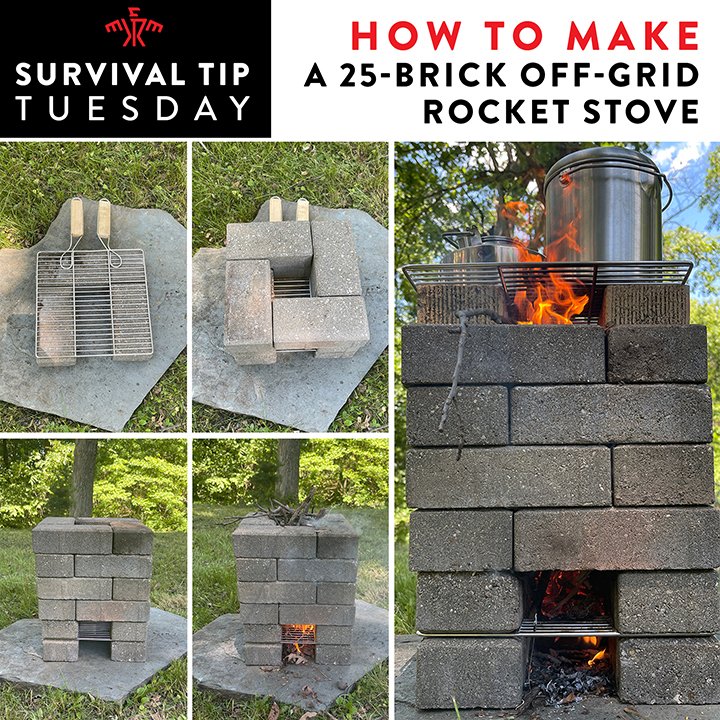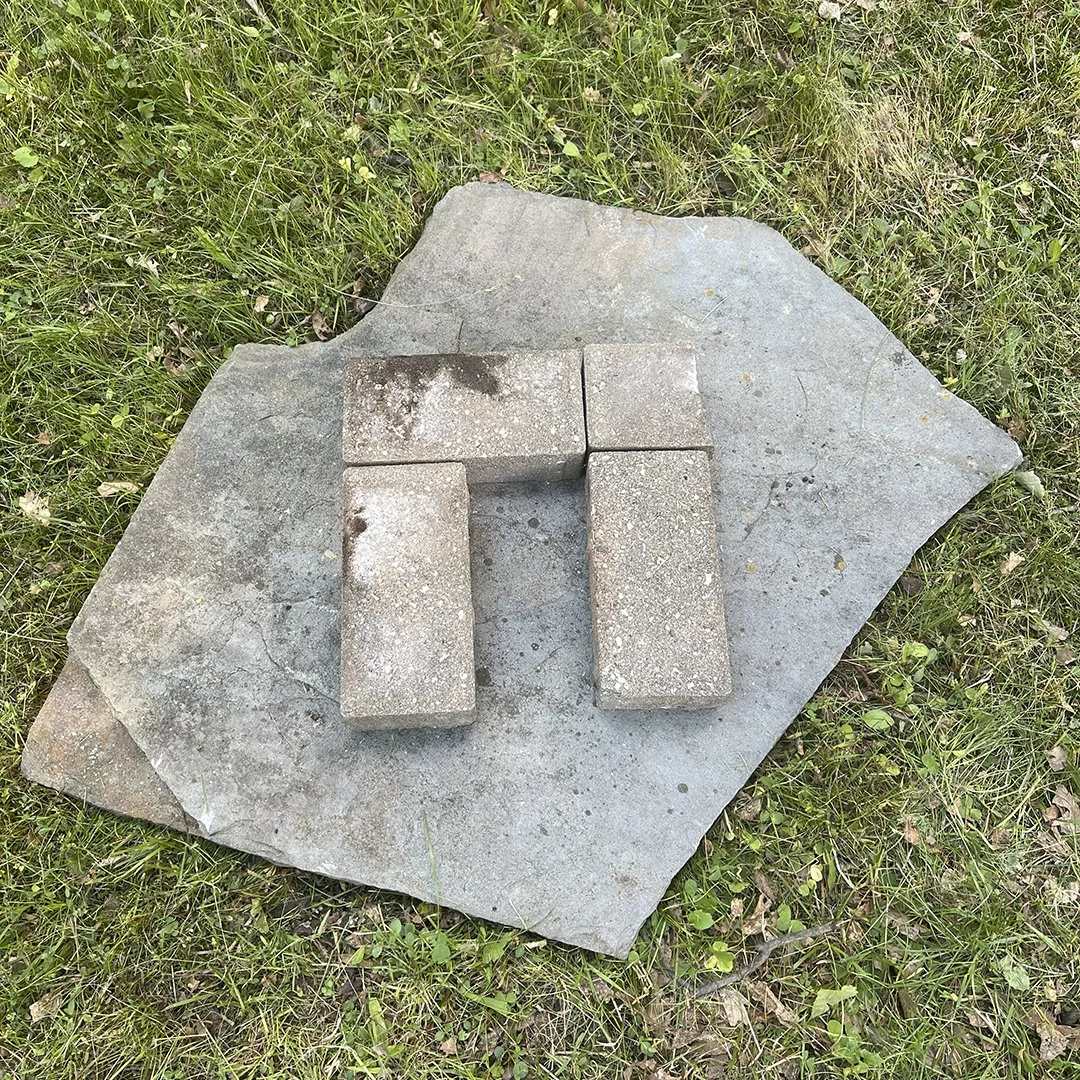How to Make an Off-Grid Cooking Stove (ROCKET STOVE) From 25 Bricks
THE NEED FOR AN OFF-GRID COOKING OPTION
Whether boiling water for purification or stir-frying fresh herbs from your raised bed garden, in this article I’ll teach you how to make a functional off-grid cooking stove when you need it most. I have personal experience implementing, building, and using this stove and it is my hope that this solutions will fit your circumstances so that you can cross this especially important preparedness item off your list. At the very least it will give you a simple and budget-friendly option when it comes to off-grid cooking.
Just one generation ago, cooking using open fire was common knowledge. It is incredible how quickly the necessary tools and equipment for cooking off-grid can become nearly obsolete – at least in North America. But you will be comforted to know that likely your grandmother, and almost certainly your great grandmother, prepared food using similar equipment, tools, fuel, and techniques – all while completely off-grid. Millions of people across the globe still cook on improvised rocket stoves, with simple utensils, using scavenged wood and twigs found nearby their homes. The style of cooking outlined below, especially those fueled by wood, is far more time-tested than any microwave, gas range, toaster, crock pot, or modern electric oven ever will be. Who knows, with a little practice, you may learn to prefer cooking “off-the-grid”!
WHAT IS A ROCKET STOVE?
The truth is that millions of people around the world cook meals every day on wood and charcoal fueled stoves. Many of these people use some version of a design called a “Rocket Stove”.
Rocket stoves are very efficient cooking stoves that consist of a combustion area and an insulated chimney. They commonly use small diameter or scavenged wood, which is available to almost anyone, even in large cities. Because of the unique design, rocket stoves produce extremely high heat and almost no smoke. They also produce extraordinarily little mess and turn wood fuel into nothing but a few spoonful’s of white ash. Because of all these advantages, I would encourage you to consider a rocket stove of some type as a back-up off-grid cooking solution.
Although I mention a couple of store-bought rocket stoves later in this article, you can make one at home for just a few dollars. Understanding how to do this is wise for your off-grid preps. In a wilderness survival scenario a similar stove can be improvised using rocks and clay to make an incredible “survival” cooking stove.
How to Make an Off-Grid Brick Rocket Stove for Cooking & Boiling
Maybe you like the idea of a rocket stove but are not ready to spend $120 on a back-up to store down in the basement for “just in case”. Well, I may have just the solution for you. It is called a 25 Brick Rocket Stove and it is the perfect almost free solution for the DIY prepper.
Hop on your local Facebook Marketplace or Craigslist and find someone giving away a pile of old bricks. Tell them you need about 28 or so. You only need 25 for this project but it is always a good idea to have a couple extra.
Start by taking a brick chisel or brick hammer and split a brick in half (wear safety glasses). If you see any half pieces when you pick up your free bricks be sure to get them, and you can save yourself this step. You will need two half brick pieces to twenty full bricks to complete this 25 Brick Rocket Stove.
Off-Grid Rocket Stove: Step 1
On a solid noncombustible surface such as dirt, gravel, or stone, place a layer of bricks in a U-shape as shown. Use one of the half-brick pieces in one of the corners to do this.
Off-Grid Rocket Stove: Step 2
Place a metal grate across the first U-shaped brick layer. You can buy cheap metal grates at the dollar store or find something else that will work. It does not have to be fancy, but it does need to be a grate to allow air flow.
Off-Grid Rocket Stove: Step 3
Build a second U-shaped layer on top of the metal grate. Use the second piece of half-brick for this layer. At this point you will have used seven bricks – 6 full and 1 split into halves. The bottom two layers and grate build the fuel feeding and combustion chamber. The grate serves as a platform for wooden sticks and allows airflow to be pulled from under the fuel and into the chimney above.
Off-Grid Rocket Stove: Step 4
Now stack a four-square of bricks as the next layer. Eleven bricks total used at this point.
Off-Grid Rocket Stove: Step 5
Stack three more four-square layers of brick. These layers will build the chimney which draws in fresh in air through the fuel chamber to flush the fire with oxygen. It is this effect that creates a very efficient and hot fire. Twenty-three bricks will be used when the chimney is complete.
Off-Grid Rocket Stove: Step 6
To start the fire, loosely pack the chimney with small dry sticks and twigs. Then, fill the fuel chamber on top of the grate with tinder material such as dry leaves, grasses, or pine needles. When you light the tinder in the fuel chamber the heat will rise. As it does it will pull in fresh air from under the tinder and provide oxygen to the fire. More oxygen will help the fire to burn hotter which will cause the air to rise faster, thus pull in more fresh oxygen. Once the fire is going well you will feed the fire with sticks through the fuel chamber. You only put sticks in the chimney to get the fire going in the beginning.
Off-Grid Rocket Stove: Step 7
The last two of the 25 bricks should be placed on either side of the chimney opening. This gives you a raised platform to place a pot or pan for cooking or boiling. A pot can be placed across these bricks or on top of another supporting grate.
You now have the knowledge to build an incredibly efficient off-grid rocket stove in under 15-minutes using 25 free bricks and a spare metal grate. But what is even more amazing is that it can be powered using scavenged sticks and twigs from just about anywhere.
Below is a video where I walk you through step-by-step how to build this off-grid rocket stove:
Commercially Available Off-Grid Rocket Stoves
Many different brands and styles of rocket stoves are available for purchase, and I have personally used most of them. For camping and hiking I use a small one called a SoloStove (link to the one I use at https://amzn.to/3QQkieD).
But when it comes to a larger at-home solution, I prefer the EcoZoom Stove.
The EcoZoom Stove is small enough to be portable and stores well in the garage or shed. It is also large enough to be a legit off-grid cooking stove for an entire family, without having to live in a forest full of wood or even own a chainsaw. According to their website (https://ecozoom.com), the EcoZoom stoves save up to 70% on fuel usage compared to an open fire or inefficient stove and produce 60% less smoke. Just a handful of sticks from the back yard or local park is enough fuel to cook an entire meal. Or you can burn any other type of biomass such as dried piles of cow dung (seriously, you can).
You can find the EcoZoom Stove on Amazon here: https://amzn.to/3R7YxbD
Some of the easiest meals to make are simple stir-fries of veggies, beans, rice, and a little meat. There is no better pan for the job than a round-bottom wok to do this. Once feature I really like about the EcoZoom Stove is that the top burner can accommodate round-bottom and flat-bottom pans. It is very awkward to cook over most stoves with a wok and it is a breeze with the EcoZoom. If you are looking for an inexpensive (around $120 on Amazon) back-up cooking stove that is not dependent on gas, propane, or any other grid-tied fuel, I would encourage you to look at this stove. Mine has served me well over the several years in times of recreation and necessity.
THE DISASTER READY HOME
Is your home Disaster Ready? If not, consider picking up my book, The Disaster Ready Home, and learn dozens of other skills like this one. You can order here at my website or on Amazon here: https://amzn.to/49NrMbe












